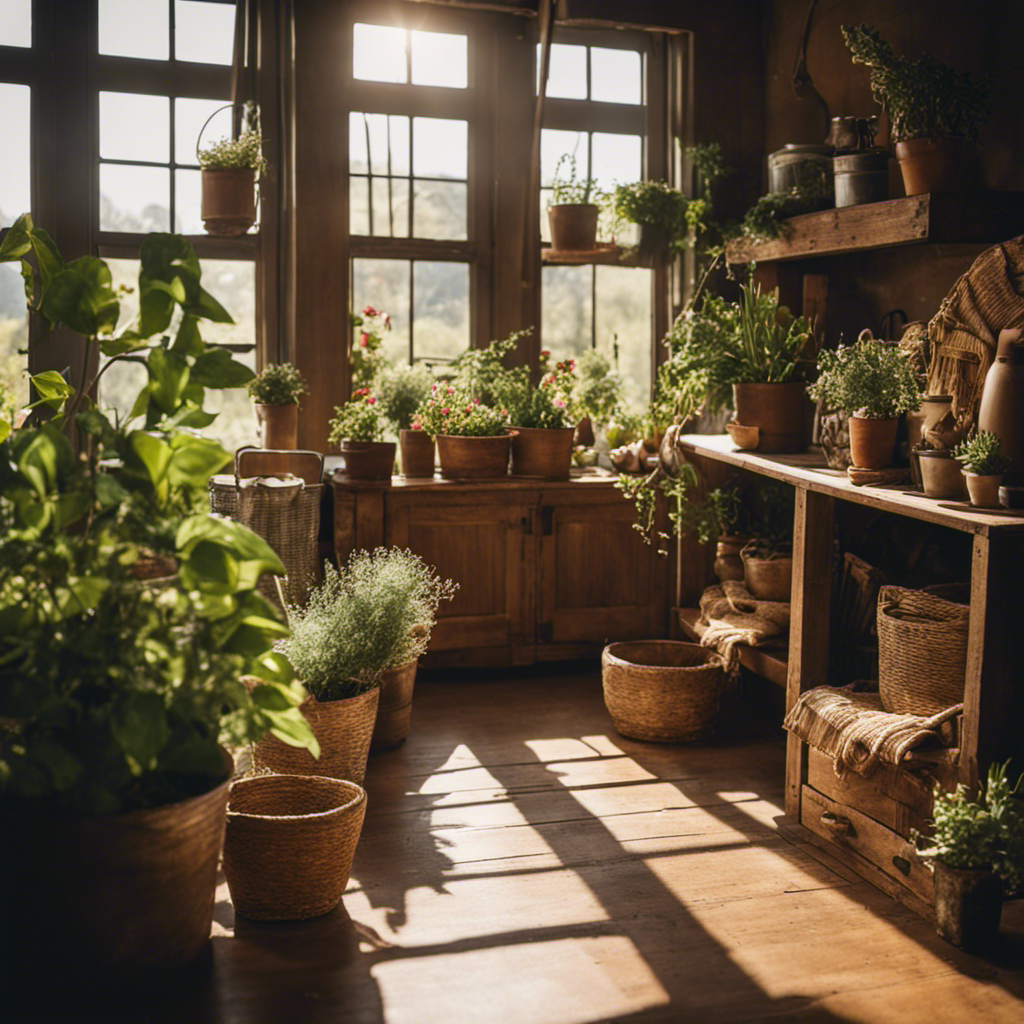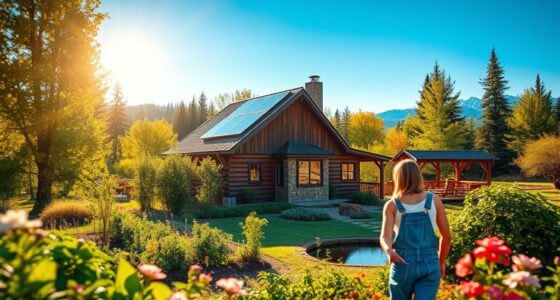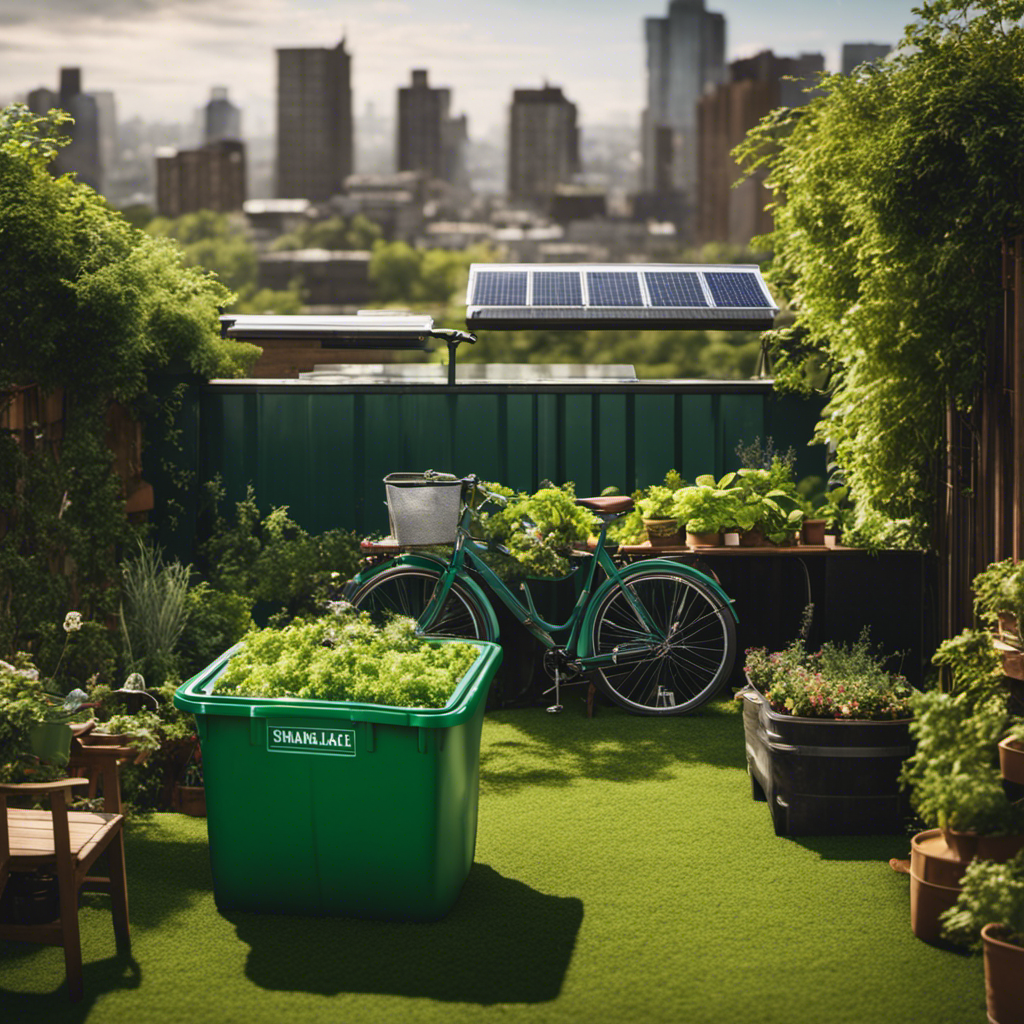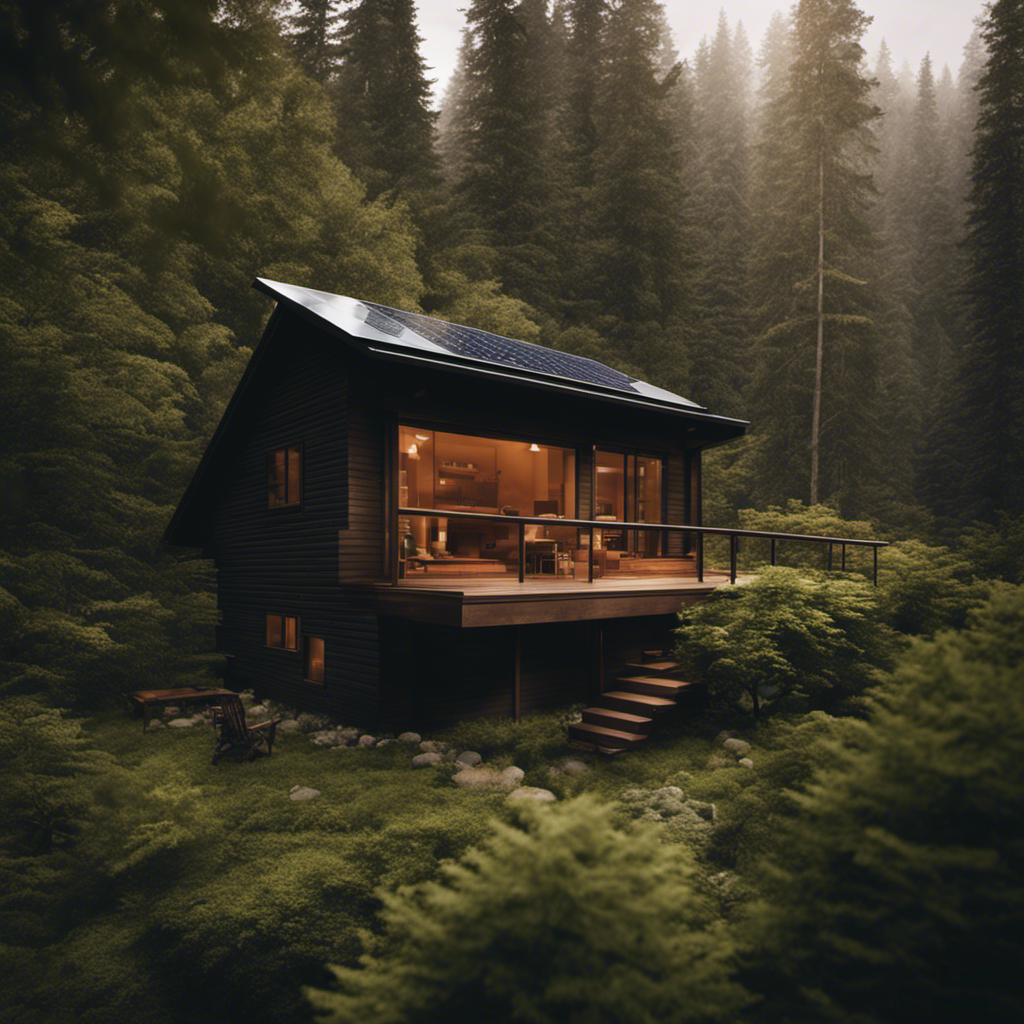Welcome to our guide on enhancing the ‘green’ aspects of your countryside retreat! We’re thrilled to share our expertise on sustainable farmhouse decor, helping you strike an ideal balance between style and eco-consciousness.
From researching sustainable materials to reducing plastic use, reusing old decor items to harnessing solar power, we’ve got you covered.
Join us as we explore the creative world of sustainable farmhouse decor and discover practical tips to make your retreat both beautiful and environmentally friendly.
Let’s get started!
Key Takeaways
- Use sustainable materials such as organic cotton, hemp, or linen for fabrics and reclaimed wood or recycled glass for decor options.
- Prioritize ethical sourcing by supporting local artisans and farmers, exploring online eco-friendly retailers, and purchasing from brands with fair labor practices.
- Supporting local artisans not only contributes to sustainable and ethical practices but also stimulates the local economy and promotes the vibrant culture of the community.
- Reduce plastic use in farmhouse decor by opting for natural fibers, using glass or ceramic containers, incorporating DIY upcycled decorations, and choosing wooden or bamboo alternatives.
Researching Sustainable Materials
We’re currently researching sustainable materials to use in our farmhouse decor. Finding the right materials that aren’t only aesthetically pleasing but also environmentally friendly is crucial for creating a truly sustainable space.
When it comes to fabric options, we’re exploring alternatives to conventional cotton, which is known for its heavy water and pesticide usage. Instead, we’re considering fabrics made from organic cotton, hemp, or linen. These materials are grown without pesticides and require less water, making them more environmentally friendly choices.
In addition to sustainable fabric options, we’re also looking into eco-friendly paint choices. Traditional paints often contain harmful chemicals and volatile organic compounds (VOCs) that can release toxins into the air, contributing to indoor air pollution. To avoid this, we’re considering paints that are labeled as low VOC or zero VOC. These paints are made without harmful chemicals and have lower emissions, making them a healthier option for our farmhouse decor.
Ethical Sourcing: Where to Buy
When it comes to ethical sourcing, there are several options to consider.
One option is to support local artisans and farmers who create sustainable products.
Another option is to explore online eco-friendly retailers that offer a wide range of ethically sourced items.
Lastly, thrift stores and flea markets can be great places to find unique and sustainable treasures.
Local Artisans and Farmers
Our favorite local artisan’s handmade pottery is available for purchase at the farmers market. Supporting local artisans not only helps to sustain their craft but also contributes to the vibrant culture of our community.
Here are three reasons why supporting local artisans at farmers markets is a great idea:
-
Unique and One-of-a-Kind: Local artisans create unique pieces that you won’t find anywhere else. Their craftsmanship reflects their passion and dedication, resulting in truly one-of-a-kind products.
-
Sustainable and Ethical: By purchasing from local artisans, you’re supporting sustainable and ethical practices. Many artisans use eco-friendly materials and processes, ensuring that their products have a minimal impact on the environment.
-
Economic Impact: Supporting local artisans keeps money within our community. When you purchase their products, you’re directly contributing to the local economy, helping to create a thriving ecosystem for artisans, farmers, and other small businesses.
Online Eco-Friendly Retailers
Let’s check out the wide range of eco-friendly products available from these online retailers that prioritize ethical sourcing.
When it comes to ethical clothing, there are numerous online retailers that offer sustainable and stylish options. From organic cotton t-shirts to recycled polyester activewear, these brands are committed to reducing their environmental impact while still delivering fashionable pieces. Not only are these clothes made with sustainable materials, but they also prioritize fair labor practices, ensuring that the people who make them are treated fairly and paid a living wage.
In addition to ethical clothing, these online retailers also offer a variety of sustainable beauty products. From natural skincare made with organic ingredients to cruelty-free makeup, these brands are revolutionizing the beauty industry by providing eco-friendly alternatives.
Thrift Stores and Flea Markets
We love browsing through thrift stores and flea markets to find unique, vintage treasures for our sustainable farmhouse decor. It’s not just about finding great deals, but also about repurposing these treasures and giving them a new life.
Here are three items we recently found:
-
An old wooden ladder that we transformed into a rustic bookshelf. It adds character to our living room and provides a practical storage solution.
-
A set of vintage mason jars that we turned into beautiful candle holders. They create a cozy atmosphere and are a perfect addition to our farmhouse-style dining table.
-
A weathered wooden window frame that we repurposed as a decorative wall hanging. It adds a touch of charm and nostalgia to our bedroom.
Thrift store bargains aren’t only budget-friendly but also allow us to contribute to sustainable living by giving old items a second chance. With a little creativity, you can transform these treasures into unique pieces that truly reflect your personal style.
Reducing Plastic Use in Farmhouse Decor
When it comes to farmhouse decor, reducing plastic use isn’t only environmentally friendly but also adds a rustic charm to your home. By opting for plastic-free alternatives such as natural fibers like jute or sisal for rugs and curtains, and using glass or ceramic containers instead of plastic for storage, you can create a sustainable and stylish farmhouse aesthetic.
Additionally, getting creative with DIY upcycled decorations, like turning old mason jars into charming candle holders or repurposing wooden crates as shelving units, allows you to add a personal touch while reducing plastic waste.
Plastic-Free Alternatives
We’ve found some great plastic-free alternatives for farmhouse decor that are both stylish and sustainable. Making conscious choices for our homes is an essential part of embracing a zero waste lifestyle. By opting for natural fiber alternatives, we can reduce our reliance on plastic and create a more eco-friendly living space.
Here are three fantastic options to consider:
-
Jute rugs: These rugs aren’t only biodegradable but also add a touch of rustic charm to any farmhouse decor. Made from natural plant fibers, jute rugs are durable, easy to clean, and come in a variety of textures and patterns.
-
Bamboo furniture: Bamboo is a fast-growing, renewable resource that can be used to create stunning furniture pieces. Its strength and versatility make it an excellent choice for farmhouse decor, providing a natural and sustainable alternative to plastic furniture.
-
Wood accents: Incorporating wooden accents into your farmhouse decor can instantly elevate the ambiance of your space. From reclaimed barn wood shelves to handcrafted wooden picture frames, these items add warmth and character while reducing the need for plastic materials.
DIY Upcycled Decorations
Let’s get creative and transform old mason jars into beautiful upcycled decorations for our farmhouse, using them as both candle holders and flower vases. Upcycling furniture and repurposing materials are great ways to add a unique touch to our living spaces while also promoting sustainability. Mason jars are versatile and can easily be transformed into stunning farmhouse decor pieces with just a few simple steps.
To inspire you, here is a table showcasing different ways to repurpose mason jars:
| Decoration Idea | Materials | How-To Guide |
|---|---|---|
| Candle Holder | Mason Jars, Beads, Twine | – Clean the jars thoroughly |
- Attach twine around the rim
- Fill the bottom with beads
- Place a candle inside |
| Flower Vase | Mason Jars, Paint, Ribbons | – Paint the jars in desired colors - Tie ribbons around the neck
- Fill with water
- Arrange fresh flowers |
Reusing Old Decor Items: Creative Ideas
We can repurpose old decor items to give our farmhouse a fresh and creative look. It’s a sustainable and cost-effective way to breathe new life into our surroundings while adding a touch of charm and character.
So, let’s explore some creative ideas for repurposing old decor items:
-
Vintage Window Frame: Transform an old window frame into a unique and rustic wall decoration. Paint it in a distressed finish or leave it bare for a shabby-chic look. Hang it on the wall and use it as a backdrop for displaying dried flowers or small potted plants.
-
Repurposed Suitcase: Turn an old suitcase into a stylish side table or storage unit. Clean it up, add some legs, and secure a piece of glass or wood on top. This repurposed furniture piece adds a touch of nostalgia while serving a functional purpose.
-
Mason Jar Chandelier: Create a stunning chandelier using mason jars and a simple DIY kit. Attach the jars to a wooden board or metal frame, add lightbulbs, and hang it from the ceiling. This unique lighting fixture adds a rustic and whimsical charm to any farmhouse space.
By repurposing old decor items, we not only reduce waste but also give our farmhouse a personalized and eco-friendly touch.
Energy-Efficient Lighting Choices
We can save energy and reduce our electricity bills by choosing energy-efficient lighting options for our farmhouse. By making simple changes to our lighting choices, we can make a significant impact on our energy consumption. One of the most effective ways to achieve this is by using energy-saving bulbs. These bulbs use less electricity and last longer than traditional incandescent bulbs, making them a cost-effective option. Additionally, we can optimize natural light in our farmhouse by strategically placing windows and skylights to maximize daylight. Not only does this reduce our reliance on artificial lighting, but it also brings a beautiful, natural glow to our living spaces.
To help you make informed decisions about your farmhouse lighting, we have created a table showcasing different energy-efficient lighting options:
| Light Bulb Type | Energy Consumption | Lifespan |
|---|---|---|
| LED | Low | Long |
| CFL | Moderate | Medium |
| Halogen | High | Short |
As you can see, LED bulbs are the most energy-efficient option, consuming the least amount of energy and lasting the longest. CFL bulbs are a good alternative, while halogen bulbs should be used sparingly due to their high energy consumption and shorter lifespan.
Water Conservation Tips for a Sustainable Farmhouse
Sometimes, in order to maintain a sustainable farmhouse, it’s important for us to implement water conservation tips and use water wisely. Water is a precious resource, and as responsible farmhouse owners, we’ve a duty to preserve it.
To help you in this endeavor, here are three effective ways to conserve water on your farmhouse:
-
Gray Water Recycling: Gray water refers to the wastewater generated from sources like sinks, showers, and laundry. Instead of letting it go to waste, we can recycle this water for non-potable purposes such as watering plants or flushing toilets. By installing a gray water recycling system, we can reduce our reliance on fresh water and minimize wastage.
-
Rainwater Harvesting: Harvesting rainwater is a simple yet effective way to conserve water. By installing rain barrels or cisterns, we can collect rainwater and use it for various household tasks like irrigation or cleaning. This not only reduces the strain on our water supply but also helps prevent stormwater runoff, which can lead to water pollution.
-
Efficient Irrigation Systems: Farmhouses often require regular watering for gardens and crops. By using efficient irrigation systems like drip irrigation or soaker hoses, we can deliver water directly to the roots, minimizing evaporation and water loss. Additionally, incorporating rain sensors or smart irrigation controllers can help optimize water usage by adjusting irrigation schedules based on weather conditions.
Harnessing Solar Power: Installing Panels
To maximize energy efficiency, let’s install solar panels on our farmhouse and reduce our reliance on traditional power sources. Solar panels are a sustainable and cost-effective way to generate electricity while minimizing our carbon footprint. With advancements in solar panel efficiency, we can now harness more energy from the sun and power our farmhouse with clean, renewable energy.
Installing solar panels on our farmhouse not only benefits the environment but also provides us with long-term financial savings. By generating our own electricity, we can reduce or even eliminate our monthly utility bills. Additionally, the government offers various incentives to encourage the adoption of solar power, such as tax credits and grants, making the initial investment more affordable.
To understand the potential savings and benefits of installing solar panels, let’s take a look at the table below:
| Solar Panel Installation | Cost | Potential Savings | Payback Period |
|---|---|---|---|
| Small-scale installation | $10,000 | $1,500 per year | 6-7 years |
| Large-scale installation | $50,000 | $7,500 per year | 6-7 years |
As you can see, the payback period for solar panel installations is relatively short, and the potential savings over time are substantial. By taking advantage of government incentives and investing in solar power, we can not only reduce our dependence on traditional power sources but also contribute to a cleaner and more sustainable future.
Composting Waste: Sustainable Farmhouse Practices
Using a large-scale composting system, we can efficiently recycle organic waste from our farmhouse, reducing our environmental impact and creating nutrient-rich soil for sustainable farming practices. Composting is a natural process that decomposes organic materials, such as food scraps, yard trimmings, and manure, into nutrient-rich compost.
By implementing a composting system on our farm, we can significantly reduce food waste and contribute to a more sustainable food system. Here are three key benefits of composting waste:
-
Reducing food waste: Composting allows us to divert food waste from landfills, where it would otherwise produce harmful greenhouse gases. Instead, the organic waste can be transformed into valuable compost that enriches our soil and helps us grow healthy crops.
-
Sustainable gardening techniques: Compost is a valuable resource for sustainable gardening. It improves soil structure, enhances water retention, and provides essential nutrients for plants. By using compost in our gardens, we can reduce the need for chemical fertilizers and pesticides, promoting a healthier and more environmentally-friendly approach to farming.
-
Closing the nutrient loop: Composting completes the natural cycle of nutrients. By returning organic matter back to the soil, we close the loop and ensure that valuable nutrients aren’t wasted. This helps maintain the fertility of our land, reduces the need for external inputs, and supports long-term sustainable farming practices.
Frequently Asked Questions
How Much Do Sustainable Materials Typically Cost Compared to Conventional Materials?
When it comes to sustainable materials pricing, eco-friendly decor options can sometimes be more expensive than conventional materials. However, it’s important to consider the long-term benefits and savings that come with using sustainable materials.
While the upfront cost may be higher, sustainable materials are often more durable and require less maintenance, which can save you money in the long run. Additionally, investing in eco-friendly decor supports a more sustainable and environmentally conscious lifestyle.
Are There Any Specific Certifications or Labels to Look for When Sourcing Ethically-Made Decor Items?
Certifications and labels for ethically made decor items play a pivotal role in supporting sustainable brands and artisans.
When sourcing for eco-friendly decor, look for certifications like Fair Trade, Forest Stewardship Council (FSC), and Global Organic Textile Standard (GOTS). These labels ensure that the products are made with ethical practices, from sourcing raw materials to manufacturing.
What Are Some Alternatives to Plastic That Can Be Used in Farmhouse Decor?
When it comes to farmhouse decor, there are several eco-friendly options to consider as alternatives to plastic.
One popular choice is using natural materials such as reclaimed wood, bamboo, or cork. These materials not only add a rustic and charming touch to your space but also reduce the environmental impact.
Another option is to incorporate textiles made from organic fibers like hemp or linen, which are sustainable and biodegradable.
How Can I Repurpose Old Decor Items in a Creative and Stylish Way?
When it comes to repurposing decor items, there are countless creative styling ideas that can give your space a unique and stylish look. By thinking outside the box, you can transform old items into beautiful and functional pieces.
From turning an old ladder into a bookshelf to using vintage suitcases as storage, the possibilities are endless. Don’t be afraid to get creative and let your imagination run wild when repurposing old decor items for a fresh and stylish touch to your home.
What Are Some Energy-Efficient Lighting Options That Still Provide a Warm and Cozy Farmhouse Aesthetic?
When it comes to energy-efficient lighting options that still provide a warm and cozy farmhouse aesthetic, there are a few options to consider.
LED lights are a popular choice due to their long lifespan and low energy consumption.
Additionally, compact fluorescent lamps (CFLs) are another option that offer energy efficiency without sacrificing style.
It’s important to consider the cost comparison of sustainable materials versus conventional materials when choosing lighting options for your farmhouse.
Conclusion
In a world where sustainability is becoming increasingly important, it’s crucial to make conscious choices even in our rural retreats. By researching sustainable materials, ethically sourcing decor items, reducing plastic use, and reusing old items, we can create a farmhouse that’s both stylish and environmentally friendly.
With energy-efficient lighting choices, water conservation tips, harnessing solar power, and composting waste, we can truly unleash the ‘green’ in our sustainable farmhouse decor.
Let’s transform our retreats into havens of eco-consciousness and inspire others to do the same.











